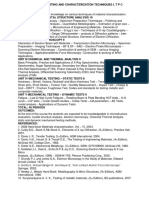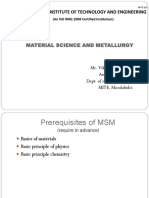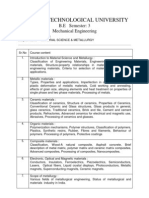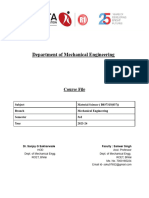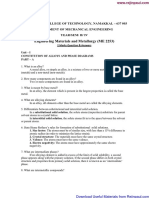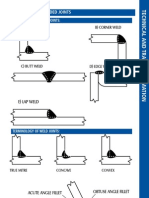Arunya: Institute of Technology and Sciences
Arunya: Institute of Technology and Sciences
Uploaded by
vijayCopyright:
Available Formats
Arunya: Institute of Technology and Sciences
Arunya: Institute of Technology and Sciences
Uploaded by
vijayOriginal Description:
Original Title
Copyright
Available Formats
Share this document
Did you find this document useful?
Is this content inappropriate?
Copyright:
Available Formats
Arunya: Institute of Technology and Sciences
Arunya: Institute of Technology and Sciences
Uploaded by
vijayCopyright:
Available Formats
KARUNYAINSTITUTE OF TECHNOLOGY AND SCIENCES
(Declared as Deemed to be University under Sec. 3 of the UGC Act 1956)
Karunya Nagar, Coimbatore – 641 114
DEPARTMENT OF MECHANICAL ENGINEERING
DETAILED TEACHING PLAN
Subject Name : Materials Science and Engg. Subject Code: 17ME2002 Credit: 3:0:0
Name E-mail Mobile
Faculty Details Dr. S. J. Vijay vijayjoseph@karunya.edu 9944516658
Class II year B. Tech Semester From: Jul. 2018 To: Oct. 2018
Class Timings Tue. – 2.55 pm; Wed. - 9.10 am; Class Location MELH202
Fri. - 9.10 am
Course Objective
1. To impart knowledge of the properties and applications of various engineering materials
2. To expose testing methods and procedures to find the mechanical properties of engineering materials
3. To acquire knowledge on construction of phase diagrams and also the importance of iron-iron carbide phase diagram
and different heat treatment
Course Outcome
Ability to
1. Identify crystal structures of common engineering materials. Understand the principle of various microscopes
2. Identify the various behavior of materials and defects
3. Analyze failures and predict service behavior of materials for various applications Interpret and determine the right
compositions of metals
4. Select the heat treatment process based on the metals
Course Content
CRYSTALLOGRAPHY: Classifications of materials- metals, Ceramics, Composites, Polymer – properties of engineering
materials – Structure of solid metals –BCC, FCC and HCP structures, atomic packing factor, polymorphism- Miller indices.
Metallographic analysis- Optical microscope, SEM, TEM.
MECHANICAL BEHAVIOR: Defects in crystals -point defects line defect edge and screw dislocations – propagation of
dislocation - Frank Read source – surface imperfections - diffusion - mechanisms of diffusion - Fick’s Laws of diffusion – plastic
, deformation- slip and twinning – recovery re-crystallization and grain growth.- strengthening mechanisms strain hardening
precipitation hardening.
FAILURE OF MATERIALS: Fracture – ductile and brittle fracture - Griffith’s theory of crack propagation protection against
fracture-Creep- mechanisms of creep – creep resistant materials. Fatigue failure, SN curve- prevention of fatigue, failure.
PHASE DIAGRAMS: Solid solution, Phases- phase diagrams- Gibbs phase rule- cooling curves, types of Equilibrium diagrams,
lever rule –Iron –Iron Carbide equilibrium diagram
HEAT TREATMENT OF STEEL & NON FERROUS ALLOYS: Annealing normalizing - spheroidising- hardening, tempering
– Hardenability, Case hardening of steels- carburizing- nitriding, induction hardening- flame hardening, Age hardening of
Aluminium alloys
Text Books:
1. V. Raghavan., “Material Science and Engineering”, Prentice Hall of India Pvt. Ltd, New Delhi, 2009.
2. Williams D. Callister “Material Science and Engineering” John Wiley and sons inc. 2014.
Reference Books
1. Reza Abbaschian, Lara Abbaschian, Robert E. Reed-Hill, “Physical Metallurgy Principles”, Cengage Learning, 2013.
2. Raymond A Higgins “Engineering Materials (Applied Physical Metallurgy) English Language book, society, 2003.
3. Khanna O.P., “A text book of Materials Science and Metallurgy” DhanpatRai and Sons Delhi, 2014.
4. Sydney H. Avner, “Introduction to Physical Metallurgy”, 2nd edition McGraw Hill Book Company, 2008.
5. Kenneth G. Budinski and Michael K. Budinski, “Engineering Materials: Properties and Selection”, Pearson Education India,
2016
Signature of the faculty Signature of the HOD
MICRO LESSON PLAN
17ME2002 – MATERIAL SCIENCE AND ENGINEERING (Credits 3:0:0)
Unit Lecture Book & Date
Topic
No. No. Page Nos. Taught
1 Introduction
2 Classifications of materials
3 Properties of engineering materials
4-5 Structure of solid materials: BCC
1 6 FCC structure , HCP structures, atomic packing factor
7 Polymorphism
8 Miller indices
9 Metallographic analysis- specimen preparation
10 Optical Microscope, SEM, TEM
11 Defects in crystals -point defects
12 Line defect edge and screw dislocations
13 Propagation of dislocation - frank read source
14 Surface imperfections
15 Diffusion - mechanisms of diffusion
2
16 Fick’s laws of diffusion
17 Plastic deformation- slip and twinning
18 Recovery, re-crystallization and grain growth
19 Strengthening mechanisms, strain hardening
20 Precipitation hardening
21 Fracture – ductile
22 Brittle fracture
23 Griffith’s theory of crack propagation
24 Protection against fracture
3
25 Creep- mechanisms of creep – creep resistant materials
26 Equi cohesive temperature
27 fatigue failure SN curve
28 Prevention of fatigue failure
29 Solid solution
30 Hume Rothery rule, Phase diagrams
31 Gibbs phase rule
32 Cooling curves, Types of equilibrium diagrams
33 Lever rule
4 34 - 37 Iron carbide equilibrium diagram
38 TTT diagram
39 Effect of cooling rates and alloying elements
40 Annealing , spheroidising
41 Normalizing
42 Hardening, tempering
43 Iso thermal annealing
44 Austempering
45 Martempering
5
46 Hardenability
47 Jomny’s test for hardenability
48 Case hardening- carburizing
49 Nitriding, Carbonitriding
50 Induction hardening, flame hardening
51 Age Hardening of Aluminum Alloys
You might also like
- Me6403 Emm PDFDocument116 pagesMe6403 Emm PDFRAMESHKUMAR.S MCE-LECT/MECHNo ratings yet
- B49 15 PDFDocument8 pagesB49 15 PDFUniversal LaboratoryNo ratings yet
- Kina22059ens 002Document167 pagesKina22059ens 002Pat ÁnNo ratings yet
- Welding Technology FundamentalsDocument20 pagesWelding Technology FundamentalsAli BurguluNo ratings yet
- Stainless Steels An Introduction and Their Recent DevelopmentsqqwDocument11 pagesStainless Steels An Introduction and Their Recent Developmentsqqwaghosh704100% (2)
- Applied MaterialsDocument3 pagesApplied Materialsshashank raj kumarNo ratings yet
- Bmee209l Materials-science-And-Engineering TH 1.0 67 Bmee209lDocument3 pagesBmee209l Materials-science-And-Engineering TH 1.0 67 Bmee209lKrijayNo ratings yet
- 1 THDocument2 pages1 THAditya TNo ratings yet
- Course Plan: Department of Mechanical EngineeringDocument12 pagesCourse Plan: Department of Mechanical EngineeringMalagouda PatilNo ratings yet
- Ceramic Tech SyllabusDocument36 pagesCeramic Tech SyllabusvishwanathanskNo ratings yet
- Indian Institute of Technology Roorkee: PRS: Mte: Ete: Pre: 1Document2 pagesIndian Institute of Technology Roorkee: PRS: Mte: Ete: Pre: 1DeepanjanMajheeNo ratings yet
- Material Science SyllabusDocument2 pagesMaterial Science Syllabus1DA20ME023 Girish M BNo ratings yet
- Final Version of 5-8 Sem Detailed Scheme - Syllabus MME NIT RaipurDocument76 pagesFinal Version of 5-8 Sem Detailed Scheme - Syllabus MME NIT RaipurprashantjnvlkhNo ratings yet
- Engineering Materials: Course Type Sub. Abbrev. Name of Course L T P CreditDocument1 pageEngineering Materials: Course Type Sub. Abbrev. Name of Course L T P Creditprashant kumarNo ratings yet
- TK 0?usp SharingDocument3 pagesTK 0?usp SharingETHIO GamingNo ratings yet
- ME208 Material Science II 2024 Spring SyllabusDocument3 pagesME208 Material Science II 2024 Spring SyllabusgoooodlookinNo ratings yet
- Materials Testing and Characterization TechniquesDocument1 pageMaterials Testing and Characterization TechniquesdsathiyaNo ratings yet
- 113106032Document2 pages113106032sreeNo ratings yet
- Course Outline, Materials IIDocument2 pagesCourse Outline, Materials IItedy yidegNo ratings yet
- 3131904Document4 pages3131904janakNo ratings yet
- 3.1 Material ScienceDocument12 pages3.1 Material Sciencepuneet375No ratings yet
- Btech Syllabus 4th Semester PDFDocument11 pagesBtech Syllabus 4th Semester PDFAmAn DeEpNo ratings yet
- ME 2293 Course Plan Fall 2023Document4 pagesME 2293 Course Plan Fall 2023Tashin Ahmed AponNo ratings yet
- AM Material ScienceDocument4 pagesAM Material ScienceTushar Mani AgarwalNo ratings yet
- Syallabus PH 8251 Material ScienceDocument2 pagesSyallabus PH 8251 Material ScienceAkhil KumarNo ratings yet
- PHRE 415 - Metallurgy and Workshop PracticesDocument2 pagesPHRE 415 - Metallurgy and Workshop Practicesasphaltnoob8No ratings yet
- Mangalore Institute of Technology and Engineering: Material Science and MetallurgyDocument203 pagesMangalore Institute of Technology and Engineering: Material Science and MetallurgyNISHAANTH S 1861462No ratings yet
- Chapter 1 IntroductionDocument42 pagesChapter 1 IntroductionSergio SyamilNo ratings yet
- Ah PDFDocument110 pagesAh PDFrocktallicaNo ratings yet
- MME 443 Production Metallurgy, by DR C.S Obayi Lecture Note Modules 1-4Document38 pagesMME 443 Production Metallurgy, by DR C.S Obayi Lecture Note Modules 1-4Elvis oziokoNo ratings yet
- Metallurgical and Materials Engineering: M.Tech. ProgramsDocument17 pagesMetallurgical and Materials Engineering: M.Tech. ProgramsSachith Praminda RupasingheNo ratings yet
- PM8391 Materials Technology L T P CDocument1 pagePM8391 Materials Technology L T P CSam CharlesNo ratings yet
- Advanced Materials and Processes: Course OutlineDocument1 pageAdvanced Materials and Processes: Course OutlineSebastián Díaz ConstanzoNo ratings yet
- Comprehensive VivaDocument9 pagesComprehensive VivaSAURABH KUMAR PANDEY Research Scholar, Chemical Engg. & Technology , IIT(BHU)No ratings yet
- II Year Emm Edited PDFDocument91 pagesII Year Emm Edited PDFMECHANICAL SMCETNo ratings yet
- MME SYLLABUS 5th-8thSEM-1Document82 pagesMME SYLLABUS 5th-8thSEM-1gurralagnaneshwar24No ratings yet
- Unit 3 Preparation of Bulk Nanocrystalline MaterialsDocument56 pagesUnit 3 Preparation of Bulk Nanocrystalline Materialsbt2O1O5134 Karan GuptaNo ratings yet
- Lesson Plan: Page 1 of 6 Unit: I Branch: B.E. Mechanical Engg. Semester: IVDocument6 pagesLesson Plan: Page 1 of 6 Unit: I Branch: B.E. Mechanical Engg. Semester: IVDinesh Kumar R100% (1)
- Engineering MaterialsDocument2 pagesEngineering MaterialsRïtämPäl100% (1)
- Foundations of MSE 510.106 2017 Fall Syllabus PDFDocument5 pagesFoundations of MSE 510.106 2017 Fall Syllabus PDFGrant ChenNo ratings yet
- Introduction To Materials Science - HistoryDocument5 pagesIntroduction To Materials Science - HistoryBhaskara P AcharNo ratings yet
- B.Sc.-VI SeDocument2 pagesB.Sc.-VI SeAryan SinghalNo ratings yet
- Lesson Plan ME-220 Engineering MaterialsDocument2 pagesLesson Plan ME-220 Engineering MaterialsHajiasifAliNo ratings yet
- COURSE EVALUATION PLAN For Theory-CY110 - Revised1Document2 pagesCOURSE EVALUATION PLAN For Theory-CY110 - Revised1itsmekrishna2006No ratings yet
- MM2023 Module1Document77 pagesMM2023 Module1mirek22938No ratings yet
- Material Science & MetallurgyDocument2 pagesMaterial Science & Metallurgyshekhadaa60% (5)
- New Syllabus With Code Revised 2017Document1 pageNew Syllabus With Code Revised 2017Senthil Kumar PNo ratings yet
- Mse 201 SyllabusDocument2 pagesMse 201 SyllabusZacheous SegunNo ratings yet
- FME 16: Material Science and Engineering: Orientation Engr. Maricel M. MatutoDocument6 pagesFME 16: Material Science and Engineering: Orientation Engr. Maricel M. MatutoCllyan ReyesNo ratings yet
- Nptel: Introduction To Crystallographic Texture and Related Phenomenon - Web CourseDocument2 pagesNptel: Introduction To Crystallographic Texture and Related Phenomenon - Web CourseAnisur RahamanNo ratings yet
- 2017 Me6403 EmmDocument116 pages2017 Me6403 EmmPaviter SinghNo ratings yet
- Course Title Course No(s) DE ZC415/MEL ZC415 Credit UnitsDocument15 pagesCourse Title Course No(s) DE ZC415/MEL ZC415 Credit UnitsUmesh BhadaleNo ratings yet
- Chapter 1. IntroductionDocument70 pagesChapter 1. IntroductionchristopherfajanNo ratings yet
- Emt 2132 Introduction To Material Science PDFDocument52 pagesEmt 2132 Introduction To Material Science PDFStephanie MirañyiNo ratings yet
- Note For Introduction To Materials MST 510Document147 pagesNote For Introduction To Materials MST 510Khairul BarsriNo ratings yet
- Physics Notes PDFDocument138 pagesPhysics Notes PDFVishak Mendon100% (1)
- Mmed Nit Srinagar SyllabusDocument99 pagesMmed Nit Srinagar SyllabusdikshitbhatotiaNo ratings yet
- Course Work Material ScienceDocument29 pagesCourse Work Material ScienceSameer SinghNo ratings yet
- De ZC415 Course HandoutDocument14 pagesDe ZC415 Course Handoutgofem10387No ratings yet
- Advances in Ceramics - Characterization, Raw Materials, Processing, Properties, Degradation and HealingDocument382 pagesAdvances in Ceramics - Characterization, Raw Materials, Processing, Properties, Degradation and Healingnitinjaiswallive100% (1)
- उत्पादन अभियाांभिकी भििाग Department of Production EngineeringDocument1 pageउत्पादन अभियाांभिकी भििाग Department of Production Engineeringshakti mohantyNo ratings yet
- 4 DMX5204Document1 page4 DMX5204DANUTH ILLUKKUMBURANo ratings yet
- An Introduction to Materials Engineering and Science for Chemical and Materials EngineersFrom EverandAn Introduction to Materials Engineering and Science for Chemical and Materials EngineersNo ratings yet
- Quik BibDocument5 pagesQuik BibvijayNo ratings yet
- Attendance List 2021 8 24 - 10 - 59 - 33Document1 pageAttendance List 2021 8 24 - 10 - 59 - 33vijayNo ratings yet
- Attendance List 2021 8 6 - 12 - 44 - 48Document1 pageAttendance List 2021 8 6 - 12 - 44 - 48vijayNo ratings yet
- 2014 Passed SyllabusDocument73 pages2014 Passed SyllabusvijayNo ratings yet
- Chess Score SheetDocument1 pageChess Score SheetvijayNo ratings yet
- Seven Wonders of The WorldDocument10 pagesSeven Wonders of The WorldvijayNo ratings yet
- Tableting SpecificationsDocument14 pagesTableting Specificationsfopcu91100% (6)
- Engineering Materials and Metallurgy (ME 2253)Document23 pagesEngineering Materials and Metallurgy (ME 2253)Praven KumarNo ratings yet
- European Steel and Alloy Grades: X8Nicralti32-21 (1.4959)Document2 pagesEuropean Steel and Alloy Grades: X8Nicralti32-21 (1.4959)farshid KarpasandNo ratings yet
- Stainless Steel Welding NotesDocument23 pagesStainless Steel Welding NotesshruthiNo ratings yet
- Acom86 - 1+2 Engineering Properties of Duplex SS (2205, 2307) PDFDocument24 pagesAcom86 - 1+2 Engineering Properties of Duplex SS (2205, 2307) PDFpipedown456No ratings yet
- Suggested Fabrication Procedures For 20Cb-3® (Alloy 20) Stainless UNS N08020 PDFDocument55 pagesSuggested Fabrication Procedures For 20Cb-3® (Alloy 20) Stainless UNS N08020 PDFWhoNo ratings yet
- Astm A480-A480m-05Document24 pagesAstm A480-A480m-05NadhiraNo ratings yet
- Set12 Metallurgy 2,3,4,5,6Document19 pagesSet12 Metallurgy 2,3,4,5,6Pritamjit RoutNo ratings yet
- Basic Types of Welded JointsDocument21 pagesBasic Types of Welded Jointstranng100% (1)
- Sandvik 253MA Data Sheet PDFDocument10 pagesSandvik 253MA Data Sheet PDFTee Klong RungNo ratings yet
- YSS Cold Working DieDocument11 pagesYSS Cold Working DiecadcamtaiNo ratings yet
- CorrusionDocument13 pagesCorrusionmmrrmm87No ratings yet
- Lumino - HTLSDocument11 pagesLumino - HTLSvishnu ojhaNo ratings yet
- Disclosure To Promote The Right To InformationDocument15 pagesDisclosure To Promote The Right To InformationKishor JadhavNo ratings yet
- Heat Treatment ProcessDocument56 pagesHeat Treatment Processkanti Rathod100% (1)
- Soal Dan Jawaban UAS Pengantar Teknik Kimia 2012Document12 pagesSoal Dan Jawaban UAS Pengantar Teknik Kimia 2012shawn iceNo ratings yet
- Aluminum: Aluminum Extrusion Machine Aluminum SectionsDocument15 pagesAluminum: Aluminum Extrusion Machine Aluminum Sectionsedbern20005873No ratings yet
- Elecref Copperclad CatalogDocument14 pagesElecref Copperclad Catalogsanjeev banerjeeNo ratings yet
- Welding MCQDocument53 pagesWelding MCQDr.S.Ravi CIT100% (1)
- Sheet 5Document5 pagesSheet 5Mohamed AbdulazimNo ratings yet
- Steels For Automotive IndustryDocument11 pagesSteels For Automotive IndustryAndress SsalomonnNo ratings yet
- CarTech® Custom 465® StainlessDocument14 pagesCarTech® Custom 465® StainlessElkin ColoradoNo ratings yet
- Bifurcation Methodology: Basic Welding ProcedureDocument7 pagesBifurcation Methodology: Basic Welding ProcedureNischal PokharelNo ratings yet
- ASTM B75-2002 Copper TubingDocument7 pagesASTM B75-2002 Copper TubingSagar KadamNo ratings yet
- Heat Treating of Aluminum Castings: The Heat Treat DoctorDocument2 pagesHeat Treating of Aluminum Castings: The Heat Treat Doctorprakashp111No ratings yet
- European Steel and Alloy GradesDocument3 pagesEuropean Steel and Alloy Gradesfarshid KarpasandNo ratings yet
















